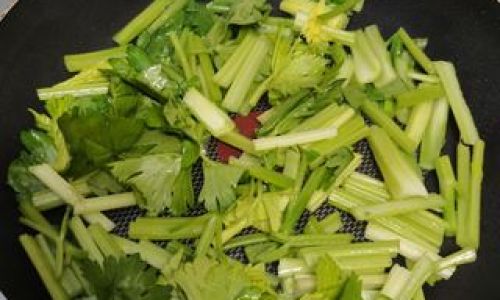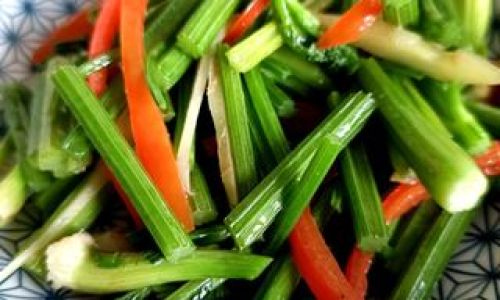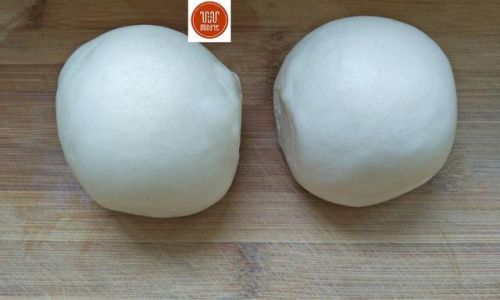Introduction
Celery, a crisp and refreshing vegetable often overlooked, holds immense potential in the culinary world. Known for its vibrant green stalks and subtle earthy flavor, celery is a staple in kitchens globally. Stir-frying, a quintessential Asian cooking technique, elevates this humble ingredient into a dish that is both nutritious and deeply satisfying. This article delves into the nuances of creating perfect stir-fried celery, exploring diverse recipes, tips, and cultural insights. Whether you are a seasoned home cook or a curious novice, this guide will equip you with the knowledge to transform celery into a star ingredient.
Why Stir-Fried Celery?
Stir-frying celery preserves its natural crunch while infusing it with aromatic flavors. The high-heat cooking method sears the vegetable quickly, locking in nutrients and texture. Celery’s mild taste acts as a canvas for bold seasonings like garlic, ginger, and chili, making it adaptable to various cuisines. Beyond its culinary versatility, celery boasts health benefits such as hydration, fiber, and antioxidants, making stir-fried celery a guilt-free indulgence.
Selecting and Preparing Celery
The foundation of a great stir-fry lies in selecting fresh, high-quality celery. Look for stalks that are firm, crisp, and free from blemishes. The leaves should be vibrant green, not wilted. Once home, trim the base and separate the stalks. Rinse them under cold water to remove dirt, then pat dry thoroughly—excess moisture can turn the dish soggy.
Cutting Techniques
The way you cut celery influences both its texture and presentation:

- Diagonal Slices: Cut stalks at a 45-degree angle for larger, visually appealing pieces that cook evenly.
- Julienne: Slice celery into thin matchsticks for a delicate texture, ideal for blending with other vegetables.
- Chopped: A rough chop works well for hearty stir-fries, where texture is less critical.
Essential Ingredients and Seasonings
While celery is the star, the right accompaniments elevate the dish:
- Aromatics: Garlic, ginger, and shallots form the flavor base. Mince or slice them thinly for even distribution.
- Proteins: Tofu, shrimp, chicken, or beef add substance. Marinate proteins briefly in soy sauce or cornstarch for tenderness.
- Sauces: Light soy sauce, oyster sauce, and a touch of sesame oil create depth. For heat, add chili paste or fresh bird’s-eye chilies.
- Add-Ins: Mushrooms, bell peppers, or carrots introduce sweetness and color.
Mastering Stir-Frying Techniques
- Heat the Wok: Preheat your wok or skillet until smoking hot. This ensures a quick sear and prevents steaming.
- Oil Placement: Add a neutral oil (like peanut or vegetable oil) and swirl to coat the pan. Avoid olive oil, which has a low smoke point.
- Aromatics First: Stir-fry garlic and ginger for 10 seconds until fragrant—burnt aromatics ruin the dish.
- Add Celery: Toss in celery and stir vigorously. Keep ingredients moving to prevent burning.
- Seasoning: Drizzle sauces around the pan’s edges to caramelize slightly before mixing.
- Finish Strong: For a glossy finish, add a splash of sesame oil or a pinch of sugar just before serving.
Classic Garlic Stir-Fried Celery
Ingredients
- 400g celery, sliced diagonally
- 3 garlic cloves, minced
- 1 tbsp vegetable oil
- 1 tbsp light soy sauce
- 1/2 tsp sugar
- 1/4 tsp white pepper
Instructions
- Heat oil in a wok over high heat. Add garlic and stir-fry 10 seconds.
- Toss in celery and stir-fry 2-3 minutes until bright green.
- Drizzle soy sauce, sprinkle sugar and pepper. Toss 1 minute more.
- Serve immediately with steamed rice.
Variation: Add a handful of cashews or dried chili flakes for crunch and heat.
Celery and Mushroom Stir-Fry
Ingredients
- 300g celery, julienned
- 150g shiitake mushrooms, sliced
- 1 red bell pepper, thinly sliced
- 2 tbsp oyster sauce
- 1 tbsp Shaoxing wine
- 1-inch ginger, grated
Instructions
- Heat oil; stir-fry ginger 15 seconds.
- Add mushrooms and bell peppers; cook 2 minutes.
- Toss in celery and stir-fry 3 minutes.
- Stir in oyster sauce and Shaoxing wine. Cook 1 minute until glossy.
Tip: Use a mix of wild and button mushrooms for earthy complexity.
Spicy Szechuan Celery with Pork
Ingredients
- 200g celery, chopped
- 100g ground pork
- 1 tbsp Szechuan peppercorns
- 2 tbsp chili bean paste
- 1 tbsp black vinegar
- 1 tbsp cornstarch (for marinade)
Instructions
- Marinate pork with cornstarch and 1 tsp soy sauce for 10 minutes.
- Stir-fry peppercorns 30 seconds until fragrant. Remove half.
- Add pork; break into crumbles. Cook until browned.
- Toss in celery and chili paste. Stir-fry 3 minutes.
- Finish with vinegar and reserved peppercorns.
Serving Suggestion: Pair with jasmine rice and a side of pickled vegetables.
Celery and Tofu Stir-Fry
Ingredients

- 300g celery, sliced
- 1 block firm tofu, cubed
- 2 tbsp hoisin sauce
- 1 tbsp rice vinegar
- 1 tbsp sesame seeds
Instructions
- Pan-fry tofu until golden; set aside.
- Stir-fry celery 2 minutes.
- Add tofu, hoisin sauce, and vinegar. Toss gently.
- Garnish with sesame seeds.
Vegan Option: Use tamari instead of soy sauce for gluten-free.
Celery Stir-Fry with Shrimp
Ingredients
- 250g celery, cut into batons
- 150g large shrimp, peeled
- 1 tbsp fermented black beans
- 1 tbsp cornstarch (for shrimp)
- 1 lime, zested
Instructions
- Toss shrimp with cornstarch and a pinch of salt.
- Stir-fry shrimp 1 minute per side; remove.
- Stir-fry celery 2 minutes. Add black beans and lime zest.
- Return shrimp; toss until heated through.
Garnish: Fresh cilantro and lime wedges.
Pairing Suggestions
Stir-fried celery complements a wide array of dishes:
- Grains: Basmati rice, quinoa, or fried rice.
- Noodles: Lo mein, chow mein, or rice noodles.
- Soups: Add to miso or egg drop soup for texture.
- Proteins: Serve alongside teriyaki salmon or kung pao chicken.
Health Benefits of Celery
- Hydration: Composed of 95% water, celery aids digestion and skin health.
- Antioxidants: Flavonoids like quercetin reduce inflammation.
- Fiber: Promotes gut health and regulates blood sugar.
- Low Calorie: A 100g serving contains just 16 calories, ideal for weight management.
Cultural Significance
In Chinese cuisine, celery (qincai) symbolizes hard work and prosperity, often served during festivals. Stir-frying, or chao, is a cornerstone of Chinese cooking, dating back over 2,000 years. The technique preserves ingredients’ natural flavors while creating harmony—a philosophy known as he.
Troubleshooting Common Issues
- Soggy Celery: Overcooking releases moisture. Cook until just tender-crisp.
- Bland Flavor: Balance saltiness with a pinch of sugar or a splash of vinegar.
- Burnt Aromatics: Ensure the wok is hot before adding oil and aromatics.
- Uneven Cooking: Cut ingredients to similar sizes for even heating.
Conclusion
Stir-fried celery is a testament to simplicity meeting sophistication. With endless variations and health benefits, it deserves a permanent spot in your recipe repertoire. Experiment with proteins, spices, and vegetables to discover your signature dish. Whether you crave heat, freshness, or umami, celery rises to the occasion—one crisp, flavorful bite at a time.
Word Count: 1,720





0 comments